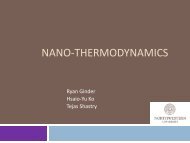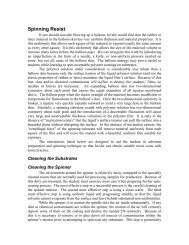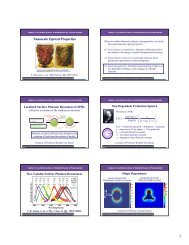A Practical Guide to SPM
A Practical Guide to SPM
A Practical Guide to SPM
You also want an ePaper? Increase the reach of your titles
YUMPU automatically turns print PDFs into web optimized ePapers that Google loves.
11<br />
Non-contact AFM<br />
Non-contact AFM (NC-AFM) is one of several vibrating cantilever<br />
techniques in which an AFM cantilever is vibrated near the surface of<br />
a sample. The spacing between the tip and the sample for NC-AFM,<br />
on the order of tens <strong>to</strong> hundreds of Ångstroms, is indicated in Figure<br />
4-1 as the non-contact regime. The inter-a<strong>to</strong>mic force between the<br />
cantilever and sample in this regime is attractive (largely a result of van<br />
der Waals interactions).<br />
In non-contact mode, the system vibrates a stiff cantilever near<br />
its resonant frequency (typically 100–400kHz) with amplitude of<br />
a few tens <strong>to</strong> hundreds of Ångstroms. The system detects changes in<br />
the cantilever’s resonance frequency or vibration amplitude. The<br />
attractive non-contact force between tip and sample is typically smaller<br />
than and more difficult <strong>to</strong> maintain than the repulsive contact force. In<br />
addition, cantilevers used for NC-AFM must be stiffer than those used<br />
for contact AFM. These are both fac<strong>to</strong>rs that make the NC-AFM<br />
detec<strong>to</strong>r signal small. Therefore, a sensitive AC detection scheme is<br />
used for NC-AFM imaging.<br />
In NC-AFM mode, Z feedback is turned on. The system moni<strong>to</strong>rs either<br />
the resonant frequency or vibration amplitude of the cantilever and<br />
keeps it constant by moving the scanner up or down in response <strong>to</strong><br />
changes. In this way, the average tip-sample distance is also kept<br />
constant and the Z feedback signal is used <strong>to</strong> generate the data set.<br />
Cantilever <strong>to</strong>rsion<br />
Torsional Resonance Mode (TRmode) AFM<br />
TRmode is a major new patented technique (Veeco Instruments) in<br />
a<strong>to</strong>mic force microscopy that measures and controls dynamic lateral<br />
forces between the AFM probe tip and sample surface. Utilizing<br />
advanced sensing hardware and electronics <strong>to</strong> characterize <strong>to</strong>rsional<br />
oscillations of the cantilever, TRmode enables detailed, nanoscale<br />
examination of in-plane anisotropy and provides new perspectives in<br />
the study of material structures and properties. It can also be<br />
interleaved with TappingMode <strong>to</strong> provide complementary lateral and<br />
vertical characterization.<br />
Figure 4-2. TRmode.<br />
Ångstrom-scale<br />
lateral tip dither<br />
In TRmode, the cantilever oscillates around its long axis in a twisting<br />
motion. This oscillation causes a dithering motion of the tip. As the tip<br />
encounters lateral forces on the sample surface, the corresponding<br />
change in the cantilever’s twisting motion is detected (the detec<strong>to</strong>r<br />
signal).<br />
This twist is detected by using a quad-cell position-sensitive pho<strong>to</strong>detec<strong>to</strong>r<br />
(PSPD). With a quad-cell PSPD, vertical deflection and lateral<br />
twist can be measured simultaneously, as shown in Figure 4-2. Note<br />
that contact AFM uses a bi-cell PSPD <strong>to</strong> measure the vertical deflection<br />
of the cantilever, indicating changes in sample <strong>to</strong>pography.
















